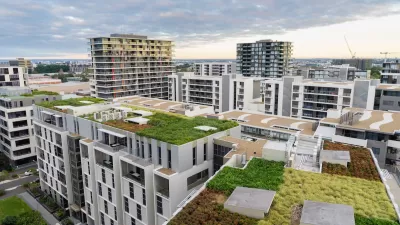Can cities stop growth? is there an ideal size for a city-region? What really matters is HOW a city grows big, not how big a city grows. Design matters. When people suggest a city is getting too big, shift the conversation from quantity to quality.

Every once in a while, I get asked by media or elected officials whether a successful, attractive city can decide to stop growing. A variation of that question is whether there's an ideal size for a city or region, and if a city can choose to stop growing at that ideal size.
I was asked those questions this week, as the Province newspaper gave front page attention to the so-called "Density Debate" surrounding the projected million more people coming to Metro Vancouver by 2040.
An Ideal City Size?
Is there an ideal city size? I've never really believed in that concept. Although some academics have postulated an ideal city size, and I've participated in such thought exercises for the "entertainment value," it's been my observation that such theories can be influenced by everything from personal preference, to ideology, to debatable assumptions, to wishful thinking.
Are medium-sized cities "better" than bigger cities? Some of the various livability rankings out there have favoured medium-sized global cities such as Vancouver, Melbourne, and Vienna – but as has been covered somewhat gleefully in global media lately, other commentators have taken pleasure in describing such medium-sized, livable cities as "sleepy and boring."
In my observation, there are great cities across the world of every size, and less-than-great (to put it kindly) cities across the world of every size. And our opinions of an ideal city size may vary as widely as people’s preferences around music or jobs. For some, New York is a horrible city that's much too big. For others, it's the best city in the world. Are either "wrong?" The relative greatness of cities of all sizes will always be subjective and a matter of opinion/debate.
What Really Matters!
I've seen ample evidence though, that what really matters is how you grow big, not how big you grow. In other words, it isn't size that matters—it's design that matters. You can have a well-designed larger city that works, or a poorly designed smaller city that's dysfunctional. Your city can get better as it grows, or worse. The key variables are the values, intelligence, and tools that shape your growth choices.
Most cities perceive growth to be a positive thing when done well, supporting such civic goals as improving affordability, enhancing ecological sustainability, supporting social equity and choice, and stimulating creativity and economic development. Again, the key issue is the nature and quality of the growth.
The most obvious example of the importance of the nature of growth, is how much of that growth is infill, suburb or sprawl. More and more cities, including many I've advised, are making the key proactive decision around how much growth will go to infill development (in both inner city and suburban contexts), and how much will go to new greenfields developments (aka new suburbs). It's a key decision for every city, a matter of civic choice based on public interest, not just a result of “market forces.”
Once that choice has been made, the next challenge is ensuring that growth in both contexts, infill and greenfields, is done better than it has been up until now. Smarter infill, smarter suburbs, no more sprawl. Remember, "suburbs" and "sprawl" aren't necessarily the same thing, and shouldn't be used interchangeably. Sprawl isn't a location—it's a design choice.
Can You Stop Growth?
Even if there was an ideal city size, could you stop growth at that size? Very few cities, especially successful cities, have tried to stop growth, and those that have tried have likely created or exacerbated other problems, not the least of which is affordability.
Trying to stop population growth in a successful city that is attracting people, talent and investment, would likely only succeed only in stopping well-planned growth. People still come—they just come in unplanned ways that translate into scenarios like Favelas in Latin America, or illegal suites in North America.
Here in Metro Vancouver, the official policy of both the City of Vancouver and the region, is to accommodate projected growth. Every municipality in the region plans to welcome its "fair share," with some proactively deciding that they'd like to have even more growth than what's projected for them, as it supports many of their municipal goals and aspirations.
Even here though, every once in a while it's suggested by some voices in a public hearing or consultation that a particular city should stop growing altogether, and that gets the media or leaders once again asking the questions that inspired this post.
That some would still suggest a no-growth scenario from time-to-time isn't really a surprise, given that it's human nature to dislike change, and we have it pretty good here. It's not unusual to want to pull up the draw-bridge behind you once you have your piece of paradise—mind you, only after you have it, not before you have it, because that would be "unfair." And why not—people are often told that home prices will just go up if there's a lack of new supply, and many interpret that as meaning their property values will go up even faster if they successfully oppose growth.
Not everyone is that cynical and self-interested mind you, and some certainly raise relevant concerns regarding growth, but often those come down to issues of quality rather than quantity. In many cities, new development isn’t always designed particularly well, so it's not surprising that growth in general can be seen as a cause for concern.
What About "Constrained" Regions?
In my recent media interview, I was also asked if the question "how big should we get" is especially important in a geographically constrained region such as Metro Vancouver? We're of course famously physically constrained by mountains, water and the U.S./Canadian border.
I've always felt that our geographic/geo-political constraints assist in the conversation about how well we grow, not just how much (although for those of you without such constraints, you can’t use that as an excuse for a lack of quality). Theoretically we have less room to sprawl—although we shouldn't kid ourselves, we've built plenty of both smart and sprawl development despite our constraints.
Growth in a constrained context can be a good thing. It can mean that as we grow more up than out, we’re improving our ecological footprint, supporting important things like public transit and walkable, complete communities, and making our region less car-dependent. But even in "unconstrained" geographies, cities are hitting fiscal "walls" relative to the staggering public costs of sprawl, or resource "walls" relative to natural resource shortages such as water, and thus are needing to achieve the same smarter, more sustainable outcomes. No one has land/money/resources to waste. It's probably fair to say that there's no such thing as an un-constrained city-region anymore.
Will We Be Better or Worse Off With the Million More?
If we try to stick our heads in the sand about the arrival of that million more people, and plan poorly for them, our region's quality-of-life may be poorer for their arrival. The obvious example is if we fail to fund transit smartly, if we design growth around cars rather than around people, and if we force those million more people to all drive because of a lack of inviting alternatives. That's a clear recipe for failure. If, however, we plan well—investing in and designing around transit, walking and biking, with mixed, diverse, healthy, complete communities—our region can get better and stronger as we grow. The key is making the right choices, with the right planning and design, and a focus on quality over quantity.
Will We Be "Finished" When the Million People Arrive?
It’s important to remember that the 1 million more people projected by 2040 is not an end state. We won't be "finished" when they arrive. Whether it takes longer or shorter than 2040 to reach the million more mark is unclear, as population projections are merely educated guesses based on assumptions. The point is to be planning to accommodate those additional million people smartly and successfully, whenever they arrive.
And what will happen after that million arrive? How many more will come? It's impossible to know, as this will be affected more by global population factors and national immigration policies than by local factors. Anyone who tells you that their crystal ball is fine-tuned that far into the future, is probably selling something. Many of the scenarios we’ve been discussing in recent years regarding global city growth though, would have significant implications—many are saying, for example, that when the full consequences of climate change start to be felt, places like our Region will become relative safe havens for global "climate refugees." That would mean a lot more pressure for growth than we've been feeling up till now. And it may happen sooner than we think.
What we do know is that cities always continue to evolve. There is never a point where city evolution stops, and the place gets frozen in amber. I'm reminded of an old way of describing good design—"never finished, but always complete." If the global population growth projections are right, we will need hundreds of new cities, or existing cities will need to get much larger, or both. The math can be intimidating. The art will be in how well we do our planning and designing for the people that are coming.
In other words, quality over quantity.

Depopulation Patterns Get Weird
A recent ranking of “declining” cities heavily features some of the most expensive cities in the country — including New York City and a half-dozen in the San Francisco Bay Area.

California Exodus: Population Drops Below 39 Million
Never mind the 40 million that demographers predicted the Golden State would reach by 2018. The state's population dipped below 39 million to 38.965 million last July, according to Census data released in March, the lowest since 2015.

Chicago to Turn High-Rise Offices into Housing
Four commercial buildings in the Chicago Loop have been approved for redevelopment into housing in a bid to revitalize the city’s downtown post-pandemic.

New Park Opens in the Santa Clarita Valley
The City of Santa Clarita just celebrated the grand opening of its 38th park, the 10.5-acre Skyline Ranch Park.

U.S. Supreme Court: California's Impact Fees May Violate Takings Clause
A California property owner took El Dorado County to state court after paying a traffic impact fee he felt was exorbitant. He lost in trial court, appellate court, and the California Supreme Court denied review. Then the U.S. Supreme Court acted.

How Urban Form Impacts Housing Affordability
The way we design cities affects housing costs differently than you might think.
City of Costa Mesa
Licking County
Barrett Planning Group LLC
HUD's Office of Policy Development and Research
Mpact Transit + Community
HUD's Office of Policy Development and Research
City of Universal City TX
ULI Northwest Arkansas
Town of Zionsville
Write for Planetizen
Urban Design for Planners 1: Software Tools
This six-course series explores essential urban design concepts using open source software and equips planners with the tools they need to participate fully in the urban design process.
Planning for Universal Design
Learn the tools for implementing Universal Design in planning regulations.























